Summary
Biodiversity is all around us. It underpins not only our economy but also our very existence: Yet, we (individuals, governments, and the private sector) are only in the early stages of understanding how essential a healthy and biodiverse environment is to a stable and well-functioning society. As the primatologist Jane Goodall wrote:
How come the most intellectual creature to ever walk earth is destroying its only home?
What is Biodiversity and why is it so Essential?
Biodiversity is a term used to describe all life on earth. It is all around us. It underpins not only our economy but also our very existence and yet society is only in the early stages of understanding how essential a healthy and biodiverse environment is to a stable and wellfunctioning society and economy. Humans, like any living creature, depend on biodiversity in three specific ways.
- Provisioning services: Such as food, energy, and medicines. For example, over 2 billion people rely on wood fuel to meet their primary energy needs.1 In addition, 70% of drugs used for cancer are natural or synthetic products inspired by nature.
- Cultural services: Nature is often tied to one’s cultural identity and plays a key role in a person’s physical and psychological wellbeing.
- Regulating services: Such as pollination, climate regulation, carbon sequestration, flood & erosion prevention, water purification, and habitat provision. For example, 75% of global food crops rely on animal pollination.2 Furthermore, marine and terrestrial ecosystems are carbon sinks for anthropogenic emissions with global gross sequestration around 5.6 gig tons of carbon per year (equivalent to 60% of global anthropogenic emissions).3 Mangrove forests are also a natural defense for flooding and protecting mangroves can provide over $US 65 billion in benefits per year.4 Coral reefs as well protect coastlines form storm damage and erosion. Finally, in Europe alone, water purification services rendered from natural habitats has been estimated to be worth up to €31 billion per year.5
A fourth category is often considered: the supporting services. They are necessary for the production of the three other ecosystem services, for example by providing plants and animals with living spaces, allowing for diversity of species, and maintaining genetic diversity.
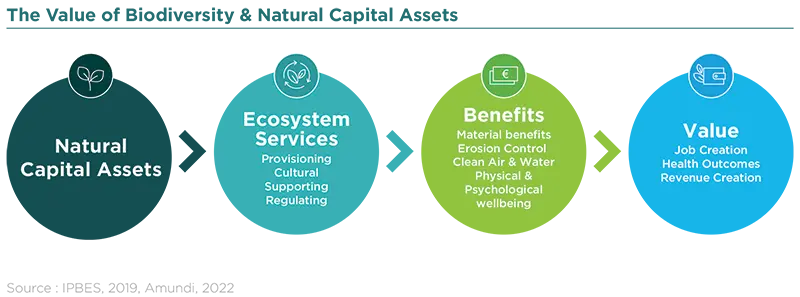
Biodiversity is in a Rapid State of Decline…
Global biodiversity is in crisis. The UN Intergovernmental Science-Policy Platform on Biodiversity and Ecosystem Services (IPBES) provides evidence that the so-called Holocene extinction is unprecedented and is a result of human activity. The IPBES Biodiversity Intactness Index (BII) estimates how much originally present biodiversity remains on average across regions. According to this index, biodiversity loss has accelerated rapidly over the last 60+ years across all regions of the globe.
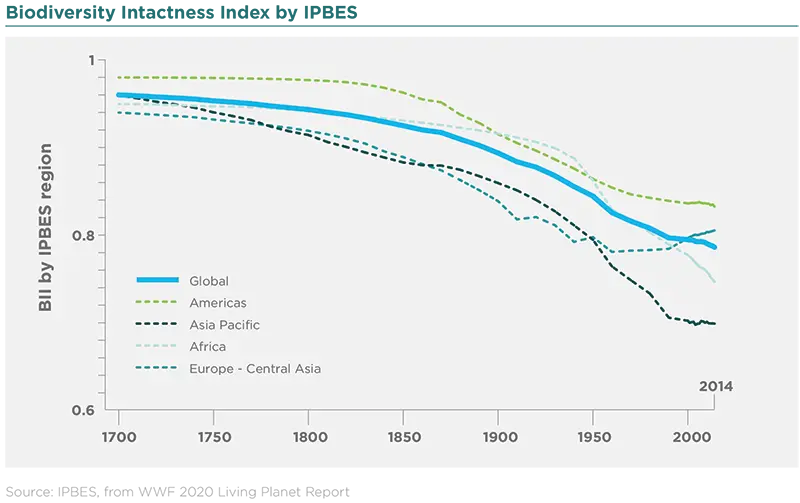
…Which Poses Significant Risks for Society
This biodiversity loss poses significant risks for corporates as well as society at large.
Risks to Food Security
For example, the biodiversity in soil plays a key role in ensuring well-functioning ecosystems such as soil formation and water purification. It also provides essential habitats for plants and animals. In essence, without soil health ecosystems collapse, which is a major threat to agricultural production.6 Agricultural production (with a value estimated in 2016 at $2.5 trillion) has increased threefold since 1970, but land degradation has reduced agricultural productivity by 23%. Furthermore, between USD $235-$577 billion of annual value of global crop output is at risk due to pollinator loss.7 With biodiversity being fundamental to food security, promoting and protecting biodiversity will be essential to feeding the world’s population.
Risks to Human Health
Biodiversity loss has also strong impacts on human health. First, while still more research is needed regarding the origins of Covid-19, the link between biodiversity loss and infectious diseases is well established. Almost three quarters of emerging infectious diseases in humans derive from other animals, also known as zoonotic diseases. Recent zoonotic diseases include Ebola, avian influenza, SARS, and HIV. Landuse change and wildlife exploitation increase people’s proximity to potential pathogens that are carried in wildlife, making the possibilities of pandemics an ever more likely occurrence.8 In addition, nature helps to purify air and water (vegetation can help absorb excessive nitrogen dioxide, ozone and particulate matter for example).9 Air pollution is estimated to be responsible for around 4.2 million deaths a year,10 meaning it is one of the leading global risk factors for air pollution related death. Far greater than the roughly 2 million people who died of Covid-19 in 2020.11
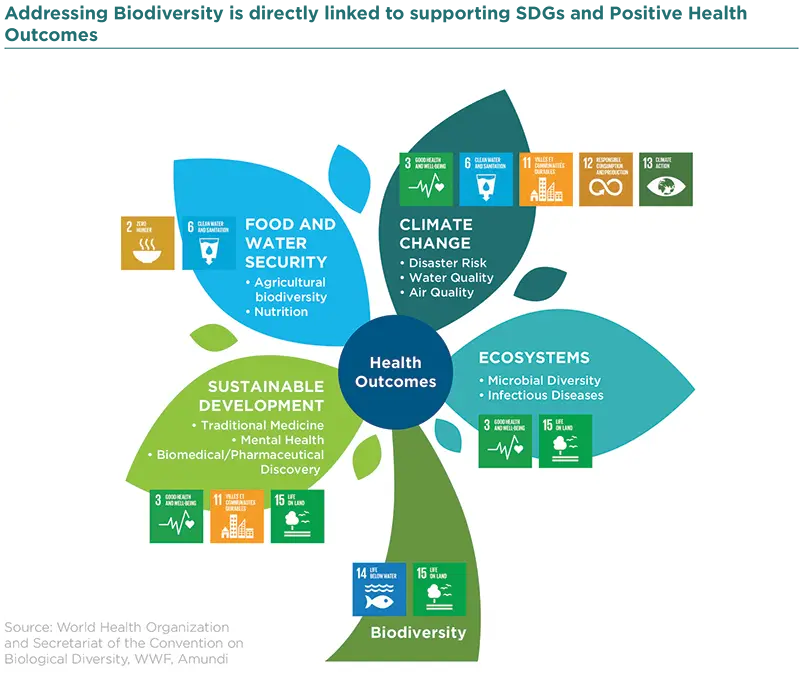
Increased Severity of Physical Events
As nature provides stable conditions in our surrounding environment, biodiversity loss exacerbates the severity of physical risks such as flooding. For example, mangroves provide extensive flood protection against chronic events like tropical cyclones. It is estimated that 35% or more of their original cover is lost and if today’s mangroves were lost, 18 million more people would face flooding every year (a 39% increase) and annual damages to property would increase by 16% to roughly $82 billion.12 The destruction of our natural habitat also exemplifies climate change, increasing the likelihood and severity of weather events (such as drought, forest fires, heavy rainfall, and hurricanes).
Human Activities are Responsible for Biodiversity Loss
Humanity’s ecological footprint has exceeded the earth’s rate of regeneration since 1970. Currently human enterprise demands 1.56 times more resources than the amount the earth can regenerate. In reality, what this means is that human activities are severely altering our planet beyond a rate that can be repaired. Human activities have severely altered 75% of land and 66% of marine environments. Roughly, 25% of assessed plant and animal species are threatened by human actions with a million species facing extinction within a few decades.13 Furthermore, ecosystems have declined in size and condition by 45% globally compared to estimated baselines.14


The Five Drivers of Biodiversity Loss
The causes of biodiversity loss can be broken into 5 primary direct drivers based on the Intergovernmental Science-Policy Platform on Biodiversity and Ecosystem Services (IPBES, 2019 classification).
Climate Change
Climate change is closely linked to the biodiversity crisis. Extreme weather conditions exacerbate climate change and alter natural ecosystems through droughts, higher temperatures, and wildfires. In turn, a loss of biodiversity can adversely impact climate change (for example deforestation reduces carbon sinks releasing significant amounts of CO2 into the air). Thus, biodiversity loss and climate change exacerbate one another, creating a vicious and perpetual cycle.
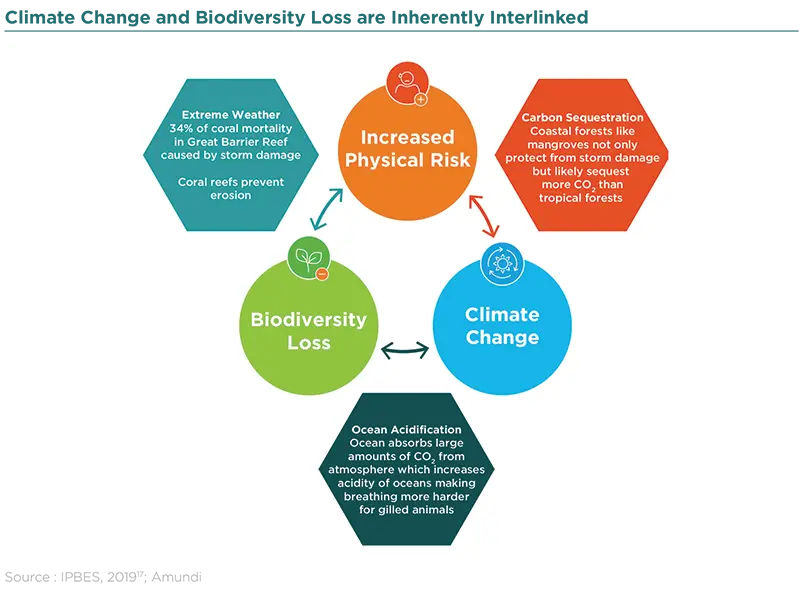
Land Degradation and Habitat Destruction
Land degradation and habitat destruction is defined as the deterioration or loss of productive capacity of soils and land. This driver is cited as the leading cause of biodiversity loss18 and there are many ways in which this driver occurs. These include over cultivation of land for agriculture that leaches nutrients from the soil, overgrazing, deforestation for agricultural production, or urbanization. Extreme weather events can also lead to habitat destruction such as fires or floods that can cause erosion and degrade soil.
Unsustainable Resource Exploitation
Unsustainable resource exploitation means harvesting resources at a rate that cannot be naturally replenished. This can includes deforestation, intensive water consumption, overfishing, and illegal wildlife trade. Over exploitation of one species can threaten food stability in an ecosystem and impact other species.19 Furthermore, resource exploitation such as intensive logging can also impact land quality and local habitats.
Pollution
Pollution is a significant contributor to biodiversity loss. This includes physical pollution such as:
- plastic and micro-plastics,
- agricultural pollutants, including pesticides and fertilizers
- hazardous and toxic waste from industrial processes
- chemical leaching from medicines and consumer products both during use and at the end of life of the products.
Many of these toxins end up in waterways and can accumulate overtime, causing harm to humans, plants, and animals alike.
Chemicals and Plastic Pollution: Pushing the Limits of Planetary Boundaries
Planetary boundaries are the environmental limits that the Earth can bear. Beyond these limits, ecological restoration is no longer possible and puts the earth at risk of becoming uninhabitable. The nine planetary boundaries (representative of the Earth’s system) were defined by 28 researchers in 2009. However, calculating the safe limits of all of these boundaries has been an ongoing process for scientists. In 2009, researchers determined that 3 of the 9 planetary boundaries had been crossed (climate change, biodiversity loss, and biogeochemical flows) with a fourth being added in 2015 (land system change).
In 2022, scientists were able to research and quantify the impact of synthetic chemicals, such as plastics on the stability of the ecosystem for the first time and concluded that we are now exceeding a 5th boundary (novel entities). The rapid growth of chemicals and plastic has led to a 50-fold increase in their production since the 1950s. Research concluded that humanity has exceeded planetary limits related to these environmental pollutants including plastics, pesticides, industrial chemicals, chemicals in consumer products, antibiotics, and other pharmaceuticals.
While simply quantifying the planetary boundary has been a major first step, the impact on the environment and human health is and could be unprecedented.2021
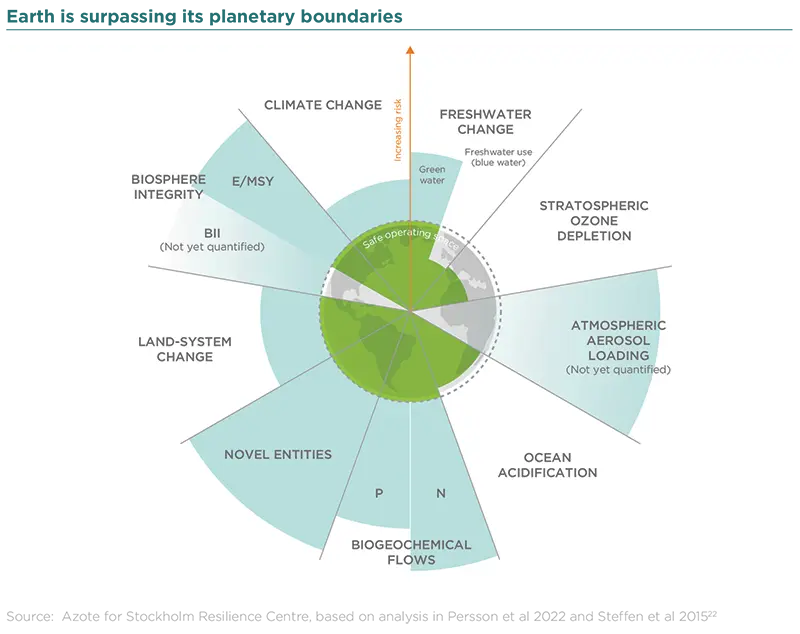
Invasive Species
Invasive Species are non-native species that are introduced to new environments. They often do not have natural predators and can cause significant damage to local species and habitats. These introductions can be intentional for commercial or recreational purposes such as the Burmese python in Florida or unintentional through shipping.
Interlinkages of the Drivers
It is important to note that the five distinct drivers of biodiversity loss are all heavily interrelated. For example, pollution can degrade soil while unsustainable resource use can lead to deforestation & habitat destruction. Despite these linkages, breaking down biodiversity impacts into the five direct drivers helps to categorize the impacts, risks, and opportunities for corporates and sectors related to biodiversity.
The Risks We Face Resulting from Biodiversity Loss
Economic growth and prosperity have come at the expense of intensive use of natural systems that underpin all life on earth. Thus, biodiversity loss resulting from human activities poses a severe risk to economic stability in our society. The World Economic Forum’s Global Risks Report has for the past five years identified biodiversity loss and ecosystem collapse as a mid to high level global risk in terms of impact and likelihood. In 2020, 2021, and 2022, the survey identified biodiversity loss as one of the top five global risks (reaching top 3 in 2022). The 2021 and 2022 reports also include infectious diseases as one of the top risks23 which again, has strong links to biodiversity loss due to zoonotic transfer.
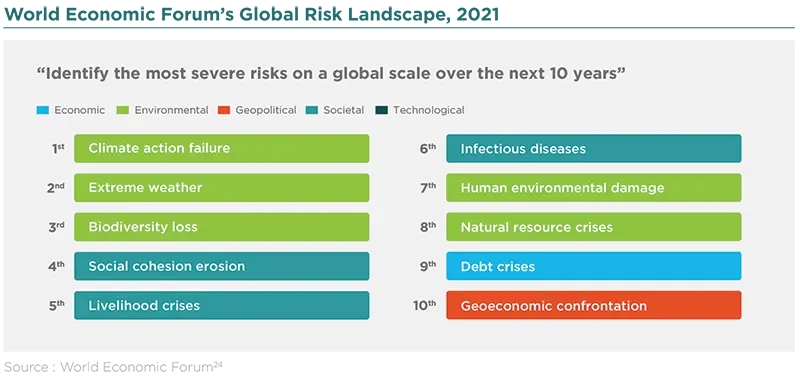
Furthermore, the estimates of the financial toll from biodiversity loss are staggering. One study25 estimated that declines in biodiversity resulted in financial losses up to $20tn per year between 1997 and 2011. Furthermore, the World Economic Forum puts the estimate of losses linked to global crop output resulting from pollinator decline between $235bn and $577bn.
Biodiversity Loss Presents Specific Risks to Companies
Corporates and corporate actions both depend on biodiversity, but also impact biodiversity loss. Heavy use of natural resources beyond the rate of natural replenishment, destruction of natural habitats, and climate change all have an impact on biodiversity, which can lead to a decline in healthy and well-functioning ecosystems. As these systems are facing increasing pressure, the stability and reliability of these ecosystem services decline, thus putting operational risks onto corporates.
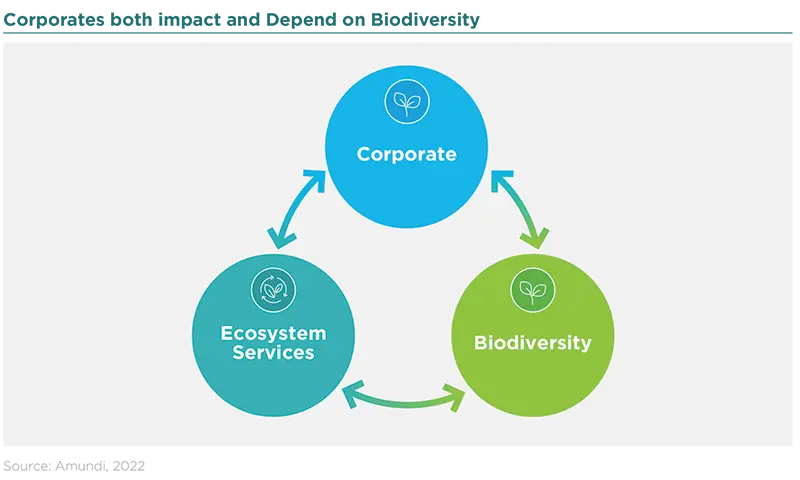
As a consequence of this interdependency, there is a huge economic cost if corporates do not address biodiversity loss. These leads to very specific biodiversity linked risks with the exposure to these risks varying between sectors and geographies. These biodiversity related risks can be divided into the following categories:
Systemic Risks
Systemic risks are associated with systemic impacts on society resulting from biodiversity loss. These far reaching impacts of biodiversity loss on food security, health, and socioeconomic development can impact the stability and functioning of financial systems. These risks span from economic, societal, to geopolitical linked issues. They include chronic diseases, malnutrition, hunger, mass migrations, or conflicts (for example water scarcity resulting from land changes and desertification can exacerbate conflicts linked to water rights). Systemic risks also include pandemics (while the origins of COVID-19 are still unknown, the crisis should nevertheless act as a wake-up call).
Physical Risks
Similar to climate change but broader in scope, corporates can face serious physical risks linked to climate change including extreme weather events such as forest fires, flooding & erosion. More specifically, physical risks can materialize into the following risks identified by the World Economic Forum26:
- Commodity risks as nature is fundamental to the performance of a business’s supply chain (e.g. in the food industry)
- Supply chain performance risks as nature can be critical to a business’s production process For example the cosmetics industry relies on shea butter in various cosmetics and the she tree is currently threatened by deforestation, parasites, and pollinator loss
- Damage and business continuity risks as nature provides stable operational conditions (physical security against acute and chronic events such as forest fires, flooding and erosion)
- Business value risk as nature enables the conditions necessary for maintaining the value of a business (e.g. in the real estate or tourism industries)
Transition Risks
Transition risks are those related to changes in regulation and consumer preferences.
- Business model adaptation risks that require a business to manage resource scarcity, reduce its dependency on nature, and protect biodiversity
- Litigation risks related to damages caused to biodiversity by land breaches in emerging legal frameworks
- Reputational risks from media and NGO campaigns, or shareholder resolutions
- Commercial risks due to shifts in consumer preferences, as the general public is growing more aware of the biodiversity crisis
- Regulation risks as governments implement more stringent policies to protect natural resources and drive this transition
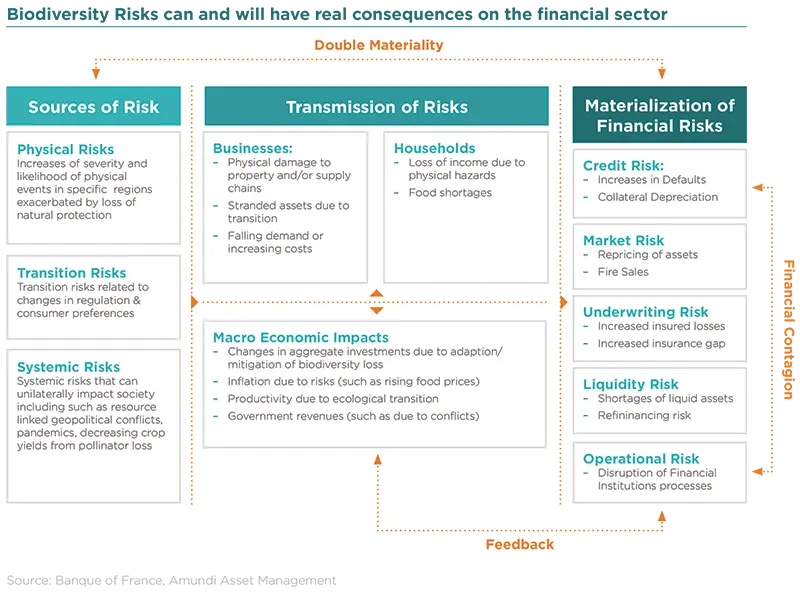
Addressing Biodiversity Loss: Also a Business Opportunity?
Despite the negatives associated with risks and harms to biodiversity, addressing biodiversity loss can also be an opportunity for corporates. The World Economic Forum (WEF) has identified this opportunity to be valued at around $10 trillion/year by 2030 and could create 395 million jobs27. These opportunities can be linked to the circular economy (for more information see our 2021 Report) or regenerative agriculture.
However, significant investments, including major technical innovation, are needed to realize these opportunities. WEF has estimated the investment requirements to be around $2.7 trillion a year through to 203028. While the price is high, a single pandemic alone (Covid-19) has been estimated to cost around $10 trillion in foregone GDP over 2020-2021.29
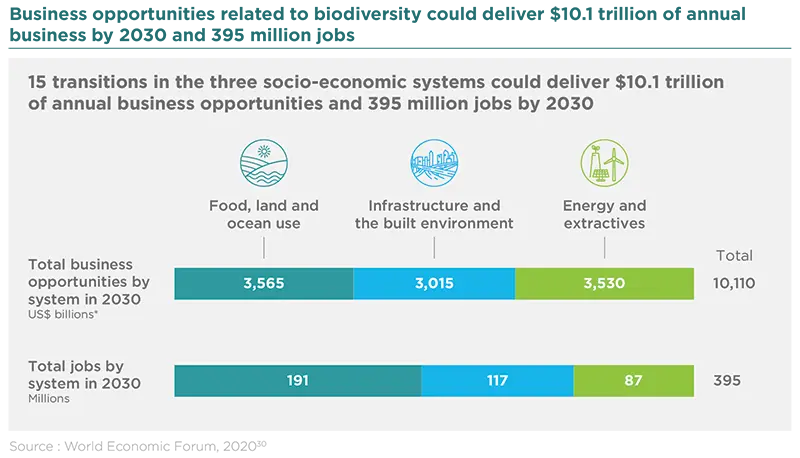
There are also opportunities in emerging megatrends such as changes in lifestyle linked to the negative impact of the biodiversity crisis. For example, digital services including video conferencing has rapidly accelerated since the pandemic and companies are becoming increasingly conscious of the climate impacts (and financial cost) of global travel when things can be done by video call. Furthermore, there are new business opportunities to capture due to changes in consumer demand driven by increased awareness of biodiversity and climate change.
Organic and Vegetarian Food: A Business Opportunity
There has been a huge increase in demand for organic food and a growing trend in people embracing flexitarian, vegetarian and vegan diets. Numerous recent consumer surveys are pointing towards the rise in plant based alternatives. For example, 42% of consumers are currently using alternative milks and more than one third of adults in the US are following a flexitarian eating plan with an additional 5% being vegetarians, 3% vegans and 3% pescatarians according to a 2020 report31.
Despite the Risks Linked to Biodiversity Loss, Corporate Action is Slow
Despite all the risks linked to biodiversity loss, companies are not addressing at a quick enough pace how they impact biodiversity. One major explanation is the complexity of the issue: impacts on biodiversity are not mutually exclusive, reporting is not standardized, and there is no one size fits all metric to evaluate biodiversity loss as there is for climate (CO2). Biodiversity loss is also not uniform. Some species and geographical locations are more vulnerable (and more valuable) than others, meaning an asset level approach is required to prioritize efforts and preserve certain species and regions. Finally, there is an overall lack of guiding scenarios as those that exist for climate change. Global metrics and targets are needed on biodiversity so they can be translated into specific goals and thresholds for companies and investors.
The Rise of New Regulation and Disclosure Standards to Bend the Curve of Biodiversity Loss
To address the many difficulties to bend the curb of biodiversity loss, there are a fair number of emerging regulations and task forces to address the issue.
Supranational Level
First, at the supranational level, COP26 on climate change in 2021 recognized the key role that biodiversity and deforestation play in addressing climate change since an estimated 23% of total emissions stem from agriculture, forestry, and other land uses32. As a result, more than 100 world leaders pledged to halt deforestation by 203033, which could signal a major push in new regulation.
Furthermore, the 15th meeting of the Convention of Biological Diversity started its first phase in October 2021 and aims to conclude negotiations around the post-2020 Global Biodiversity Framework (GBF) in Montreal in December 2022. It is considered the biggest UN convention on biodiversity in decades with countries hoping to finally strike a deal with the GBF to protect and restore nature. Past COPs have over promised and under-delivered with the 2010 Aichi targets never being fully met by the 2020 deadline while seeing biodiversity declining further. By contrast, the post-2020 GBF consists of more concrete and action oriented targets to be achieved by 2030 and long term goals for 205034.
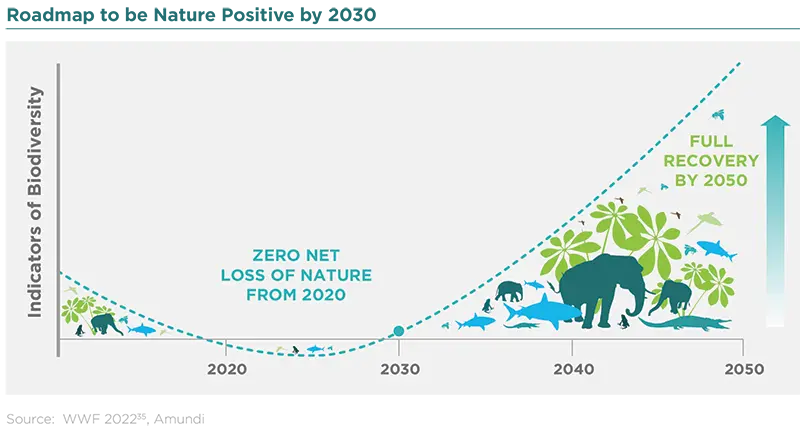
Yes, We are Actually Calling for more Regulation: Amundi’s Role in COP15
In 2021, Amundi’s notable contribution occurred during the High Level Segment of Fifteenth United Nations Conference on Biodiversity (COP 15). Amundi spoke on behalf of the Finance for Biodiversity Pledge and the financial sector to emphasize the financial community's desire to participate in the fight against biodiversity loss, as well as encourage the setting of ambitious targets for the Global Biodiversity Framework, supported by an appropriate regulatory framework. The full speech by Jean-Jacques Barberis can be read here and the full speech can be watched here.
National and International Level
In Europe, there is a growing awareness of the importance of biodiversity under the European Commission’s Biodiversity Strategy for 2030. Biodiversity will become an increasing area of regulatory focus in the EU. Under the EU Green Deal, the 2030 Biodiversity strategy lays out a long term plan for protecting nature and reversing ecosystem degradation. While the specifics around funding remain unclear, the EU outlines funding priorities for nature and green infrastructure of at least €20bn a year (both public and private funding). Within the EU Taxonomy,36 there are six environmental objectives with one specifically related to the protection and restoration of biodiversity and ecosystems. Other objectives relate to the drivers of biodiversity loss such as pollution and climate change37. According to the EU Taxonomy, for an economic activity to be classified as sustainable, it must make a substantial contribution to these six objectives, not significantly harm the other five objectives, and meet minimum safeguards.
Furthermore, the Sustainable Finance Disclosure Regulation (SFDR)38 will include biodiversity within the “adverse impacts” aspect of the regulation. Biodiversity is a standalone indicator and includes metrics around biodiversity and ecosystem protection practices, natural species, and protected areas, as well as deforestation.
Finally, according to the Non-Financial Reporting Directive in 2014, European companies must disclose environmental and social information. In France specifically under Article 29, companies39 must disclose publically in their financial reporting the environmental consequences of their activities, including CO2 emissions or biodiversity when material. In practice this means that financial institutions will have to disclose how they identify, prioritize, and manage climate (and biodiversity) related risks from 2022 and will have to expand disclosure in 2023 in line with the EU Taxonomy.40
Biodiversity Reporting Initiatives
Third party working groups are also trying to develop uniform disclosures on biodiversity from the corporate reporting side. The Task Force on Nature Related Financial Disclosures (TNFD), launched in 2021, aims to set guidelines for how companies should disclose their environmental emissions. Modeled after the TCFD (Task Force on Climate Related Financial Disclosures), the taskforce has committed to delivering a framework by 2023 for organizations to report on how they manage nature related risks. Like TCFD, the TNFD is likely to be split into three key categories:
- Governance and Strategy
- Risk Management
- Metrics and Targets
Science Based Targets Network: The SBTN is a collaboration of leading global non-profits whose mission it is to set guidance on setting science based targets. Building on the work of SBTi for climate, the SBTN is elaborating to develop standards for both nature and climate. The SBTN has identified interim targets that companies can set today in line with available science. Their upcoming methodology aims to ensure that companies are on the right path today for when science based nature targets are available41.
Partnership for Biodiversity Accounting Financials – (PBAF) currently developing a PBAF Standard to enable financial institutions to assess and disclose impacts and dependencies on biodiversity of loans and investments.42
Biodiversity Action is Coming and Companies Need to be Prepared
There is a clear need for swift action to address biodiversity loss. The severity of the risks linked to biodiversity loss has not directly translated into changes into corporate actions. While the complexities of effectively measuring and addressing biodiversity loss are acknowledged, regulations and standards to facilitate the process are being developed rapidly and companies need to be prepared to meet them head on. There are actionable steps companies can take now and investors can play a key role to accelerate the momentum of biodiversity action.
For more insights
This article is part of the series “Biodiversity: it’s time to Protect our Only Home”. To learn more about this theme, please click below on the following article.









